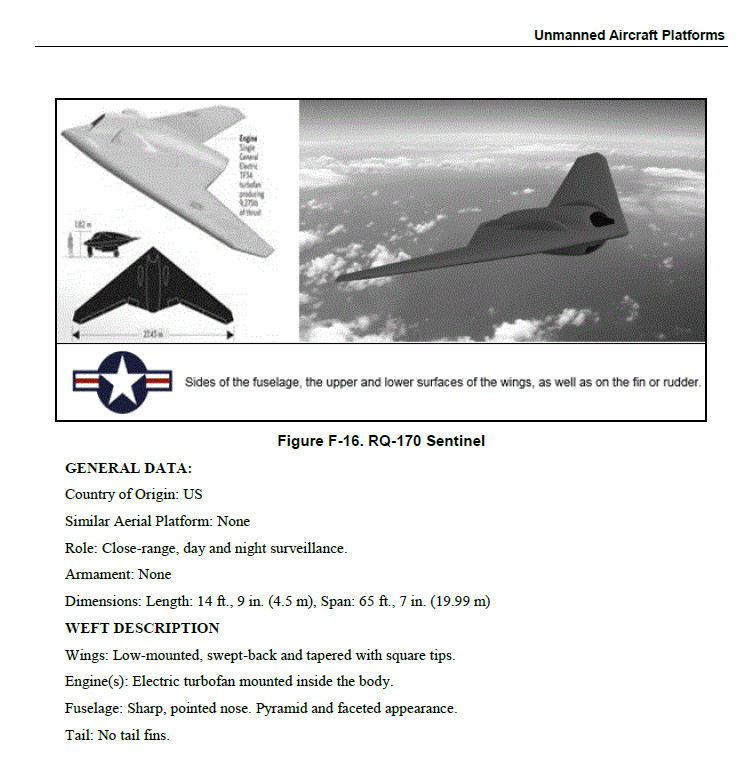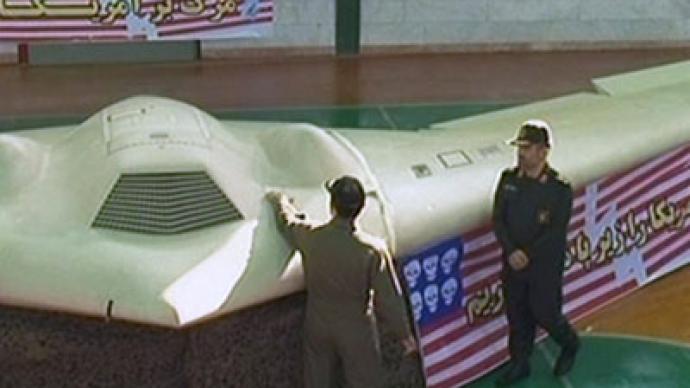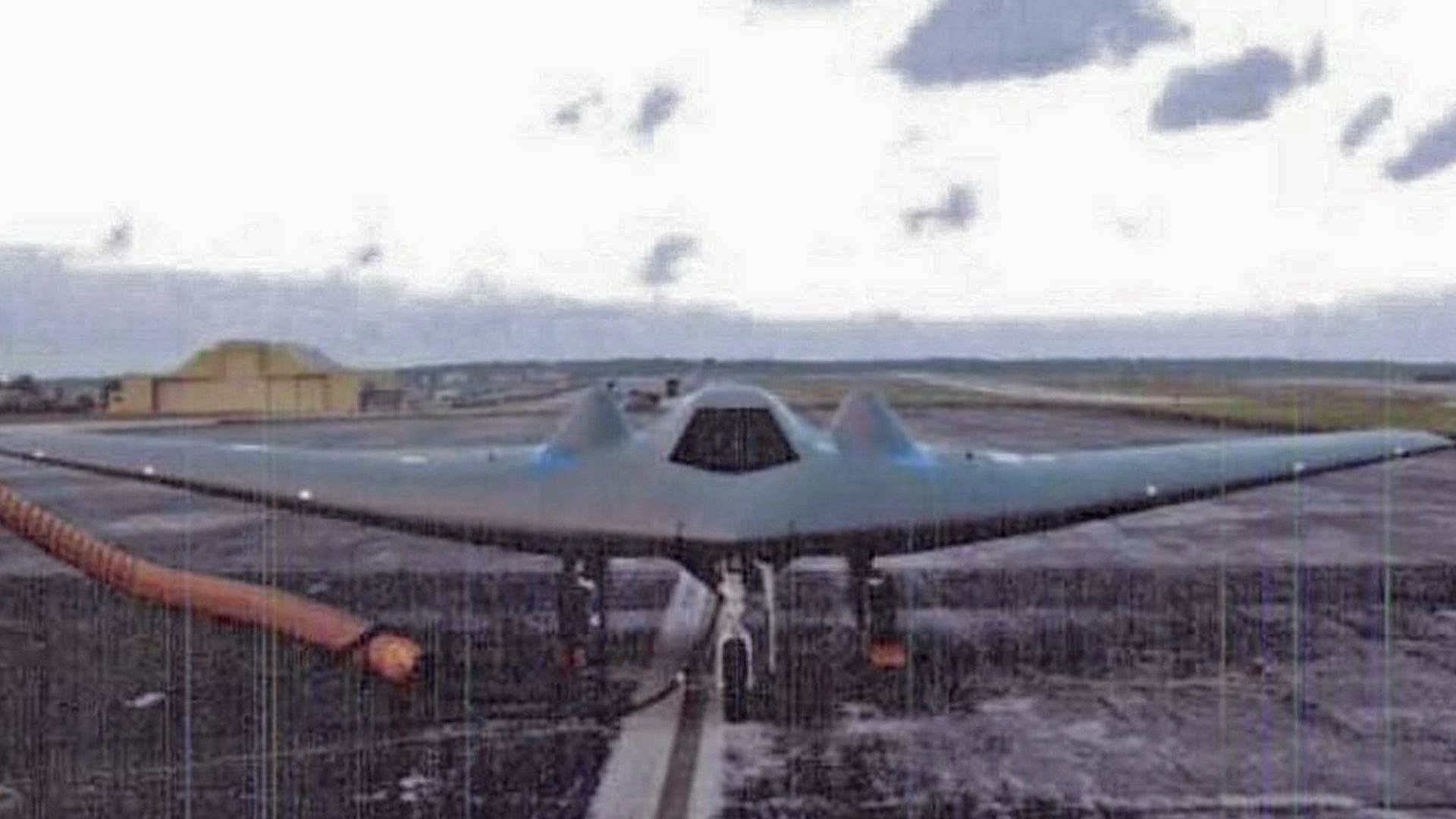There are few aircraft as closely examined—but with as few hard official details known—as the U.S. Air Force’s RQ-170 Sentinel stealth drone. The War Zone’s two primary writers have probably followed the aircraft more closely and exposed more new details about its operations than anyone else. But for more than six years, the single largest collection of official information was the service’s fact sheet, with a neat total of just 100 words. Now, additional technical facts have emerged about the secretive pilotless aircraft from an unlikely source, a U.S. Army manual.
On May 5, 2017, the Army published the latest iteration of its “Visual Aircraft Recognition” manual, or more formally, Training Circular 3-01.80. There is an entry on Lockheed’s RQ-170 tucked away in the 22-page chapter on “unmanned aircraft platforms.”
The single-page description includes a three-view line drawing and what appears to be a computer rendered concept art of the Sentinel. Some of the information is relatively mundane, some of it obvious. The wings are “low-mounted, swept-back, and tapered with square tips,” while the fuselage has a “sharp, pointed nose … [and] Pyramid and faceted appearance.” To state what is clear from any of the available pictures, the specifications point out that the drone has no tail fins.
But there are significant new details included, too. If the entry is to be believed, the RQ-170 has no longer-range sensors, with the aircraft’s role being “close-range, day and night surveillance.” This information confirms what we have thought regarding the RQ-170’s mission set as a persistent penetrating surveillance platform. The handbook also confirms that it carries no weapons.
Most notably, it provides the first official source that offers dimensions for the craft, including the Sentinel’s much disputed wingspan. According to the Army, the Sentinel has a wing-span of more than 65 feet and is nearly 15 feet long. For comparison, the wing span is more than 10 feet longer than the MQ-1 Predator, but just slightly shorter than that of the MQ-9 Reaper. The stealthy RQ-170 is significantly shorter than both of these ubiquitous drones. Once again, this is the first official source confirming those dimensions. Where the Army sourced this info remains unclear.

More curiously it states that its main engine is an “electric turbofan mounted inside the body.” This is a very confusing detail and islikely a mistake that stems from the manufacturer’s name of the Sentinel’s engine, not some exotic type of propulsion. It has been widely speculated that the RQ-170 uses a highly modified version of the General Electric TF-34 jet engine, but even if it were another General Electric engine, the catalyst for such a mistake is the same.
No other aircraft’s engine type is listed as an “electric turbofan” in the manual and no such engine exists at all, at least publicly. So, unless the RQ-170 uses some exotic new hybrid powerplant in an operational form, this anomaly is probably just that.
It’s not entirely clear why the aircraft warranted an entry in the manual to begin with. It was only mentioned in a textual list of drones in the previous edition, which the Army put out in February 2016. That version was almost comically error-ridden, widely panned online by defense journalists and hobbyists alike. It’s impressive the Army waited more than a year to print a corrected handbook.

“Aircraft manufactured by friendly countries can also be a threat in some regions depending on current situations,” the training circular notes, which is a fair point. On a separate note, this part of the introduction includes yet another factual error, suggesting, by way of example, that Iraq was flying American-made A-4 Skyhawks during the Gulf War in 1991. The Iraqis have never flown the A-4.
To go back to the Sentinel, to the best of anyone’s knowledge—and as logic would dictate—the United States hasn’t sold the aircraft abroad and the manual clearly states in its description of the RQ-170 that the drone has no foreign analogues. In December 2011, Iran did capture one of the secret aircraft after it crashed inside its territory while on an apparent surveillance mission.

Despite a U.S. government request, officials in Tehran declined to return the drone. In 2014, Iranian officials released images and video of what appeared to be a sub-scale clone that mimicked the basic shape of the Sentinel at most. That same year, Iranian Brigadier General Amir Ali Hajizadeh, the head of Islamic Revolutionary Guard Corps Air Force (IRGC-AF), boasted that the country would soon be flying a full-size version.

In 2016, pictures and video emerged of an entire fleet of larger, similarly shaped drones. State-run media outlets did not show any of them in the air. Based on what one could gleaned from the photographs and video clips, The War Zone’s own Tyler Rogoway wrote a detailed assessment of the unmanned aircraft and their likely capabilities.
And while its true that there isn’t another operational drone similar to the Sentinel that has been publicly disclosed, that might not be the case for long. Potential near-pear opponents Russia and China have both shown off prototype flying wing drones, while America’s European allies are actively working
on similar unmanned combat aircraft. As for the U.S., it remains totally unclear where the Pentagon stands when it comes to the development of stealth unmanned combat air vehicles. It goes without saying pilotless planes are already a common sight above the battlefield and will only become more prevalent as time goes on.
Is the U.S. military actually worried about these Iranian RQ-170 copies or new foreign designs? Was it just a random inclusion? It’s worth noting the manual did not include information on all the unmanned aircraft the U.S. military had in service at the time, nor did it feature any of Iran’s extensive arsenal of operational pilotless planes. With this in mind, it’s possible the authors were just looking to provide a selection of unique and representative shapes for recognition purposes.
Whatever the reason, this has given the public the next chunk of information on the shadowy Sentinel, an aircraft that remains enigmatic a decade after it was first photographed.
Contact the author: joe@thedrive.com
